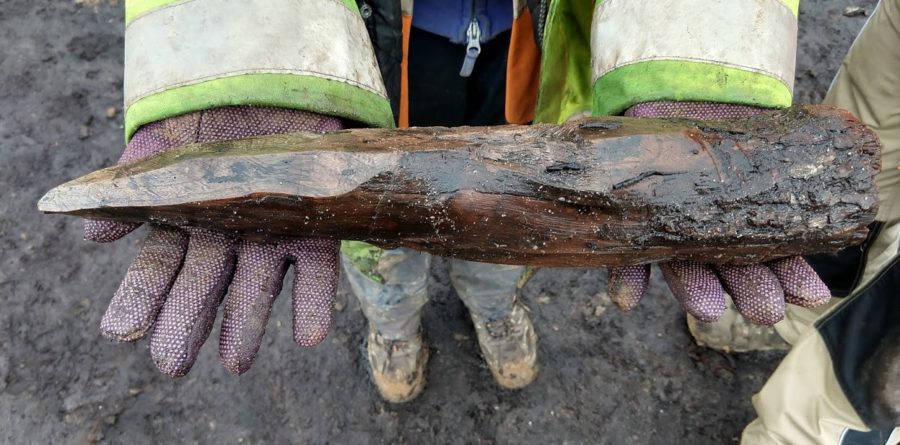9/08/2022
SCOTTISHPOWER VISION FOR GREEN HYDROGEN FUELS HUB AT PORT OF FELIXSTOWE
Contributed by ScottishPower Renewables
28/06/2018 - ScottishPower Renewables

A rare Neolithic wooden trackway, dating from 2,300BC has been uncovered at the end of one of Europe’s largest archaeological digs in recent years, forming the centrepiece of a prehistoric monument in Suffolk.
The work was commissioned by ScottishPower Renewables as part of a project to install underground cables to connect the company’s East Anglia ONE offshore windfarm to the national grid. Over the last 18 months more than 50 sites along the 37km route have been subject to archaeological exploration, but the final site has proven to hold the most significant discovery.
Around 70 archaeologists have been working near Woodbridge since February, carefully unearthing the 30 metre long wooden trackway and platform, along with numerous other features. Natural water springs, which are still evident in the area, have created conditions that led to the excellent preservation of organic materials like bone and wood. Initial theories suggest that the springs could also have been the reason that the area was chosen as a special place, over 4,000 years ago.
Beside the platform the skull of an Auroch was also discovered, an extinct species of large wild cattle, which has been carbon dated to circa 4,300 BC. The skull has been cut in a way that suggests it had potentially been used as a totem; either fixed to a pole or used as some form of headdress. At the time the trackway was built, the skull was already 2,000 years old, suggesting it was a significant item. Substantial numbers of white pebbles not common in the area were also found beside the track. The positions in which these items were found suggests that they were deliberately deposited in a way that had significance to the people at the time.
Wardell Armstrong was commissioned to oversee the entire archaeological work programme, working closely with Suffolk County Council. Up to 400 archaeologists have been involved over the last two years, with a peak on-site workforce of around 250 people at any given time. At the Neolithic site near Woodbridge, Wardell Armstrong is supervising teams from Archaeological Solutions (Bury St Edmunds), Archaeology Wales and Cotswold Archaeology.
Charlie Jordan, East Anglia ONE project Director for ScottishPower Renewables, said: “One of the unanticipated legacies of our windfarm will be a greater understanding of Suffolk’s history. In the last two years our project has been responsible for uncovering artefacts form the Bronze Age, Iron Age, Roman and Medieval periods, but is seems that best has been saved to last. We have worked closely with the archaeologists on a daily basis, and we have even made changes to our plans to ensure the site can be fully explored.”
Richard Newman, Associate Director at Wardell Armstrong said: “Undoubtedly this is a site of international archaeological significance. It is exceptionally rare to find preserved organic materials from the Neolithic period, and we will learn a great deal from this discovery. Some of the wood is so well preserved we can clearly see markings made by an apprentice, before a more experienced tradesman has taken over to complete the job. Initially some of the wooden posts looked like they were maybe one hundred years old, and it is incredible to think that they are over 4,000 years old.”
Kate Batt at Suffolk County Council Archaeological Service said: “Because organic finds of this age are so rare and vulnerable when exposed, they needed to be kept wet during excavation. The features containing the organic material have been flooded every night and the archaeologists continually sprayed the wood to keep the trackway preserved as they worked. The wood and other artefacts have been sent for further analysis, and some of the leading experts on the Neolithic period have already visited to help us build the full picture of activities on the site. Together with some of the other finds over the least two years, we hope that important artefacts can be displayed by local museums following completion of the analysis. The entire archaeological archive will be deposited with Suffolk County Council Archaeological Service, to ensure that the material remains available for future study.”
The 102 turbine East Anglia ONE project is the most cost effective offshore windfarm to go into construction in the UK. Once fully operational, East Anglia ONE will provide enough clean energy to power the equivalent of almost 600,000 homes, which is the majority of households in Suffolk and Norfolk.
All articles on this news site are submitted by registered contributors of SuffolkWire. Find out how to subscribe and submit your stories here »